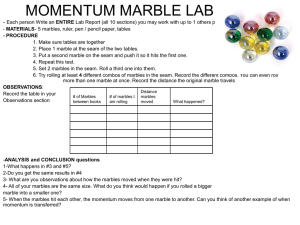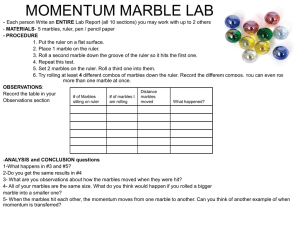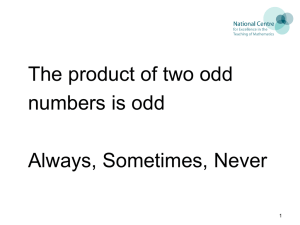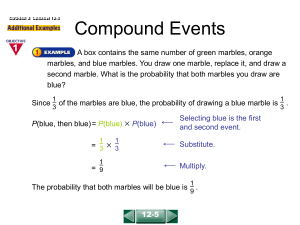Class Notes
advertisement
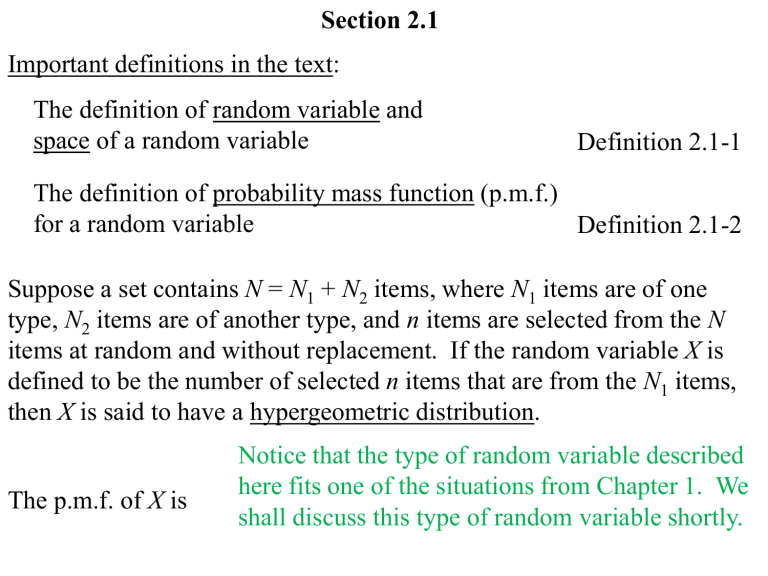
Section 2.1
Important definitions in the text:
The definition of random variable and
space of a random variable
Definition 2.1-1
The definition of probability mass function (p.m.f.)
for a random variable
Definition 2.1-2
Suppose a set contains N = N1 + N2 items, where N1 items are of one
type, N2 items are of another type, and n items are selected from the N
items at random and without replacement. If the random variable X is
defined to be the number of selected n items that are from the N1 items,
then X is said to have a hypergeometric distribution.
The p.m.f. of X is
Notice that the type of random variable described
here fits one of the situations from Chapter 1. We
shall discuss this type of random variable shortly.
The mean of X is E(X) =
Later, when we define this notation, we shall return to complete this.
To find the variance of X (using using Theorem 2.2-1), find
E[X(X – 1)] =
Later, when we define this notation, we shall return to complete this.
Since E[X(X – 1)] = E(X2) – E(X) =
then E(X2) =
and Var(X) = E(X2) – [E(X)]2 =
Later, when we define this notation, we shall return to complete this.
1. Two fair, standard, six-sided dice are to be rolled.
(a) Find the p.m.f. of the random variable X = "the difference in
number of spots between the two dice".
The 36 equally likely outcomes when the two dice are rolled are
(1,1) (1,2) (1,3) (1,4) (1,5) (1,6)
(2,1) (2,2) (2,3) (2,4) (2,5) (2,6)
(3,1) (3,2) (3,3) (3,4) (3,5) (3,6)
(4,1) (4,2) (4,3) (4,4) (4,5) (4,6)
(5,1) (5,2) (5,3) (5,4) (5,5) (5,6)
(6,1) (6,2) (6,3) (6,4) (6,5) (6,6)
The space of X is
{0, 1, 2, 3, 4, 5} .
The p.m.f. of X is f(x) =
6/36 = 1/6
10/36 = 5/18
8/36 = 2/9
6/36 = 1/6
4/36 = 1/9
2/36 = 1/18
if x = 0
if x = 1
if x = 2
if x = 3
if x = 4
if x = 5
(b) Construct a bar graph of the p.m.f. and a probability histogram of
the p.m.f.
18/36
12/36
6/36
0/36
0
1
2
3
4
5
(c) Find each of the following probabilities:
P(X = 5) = f(5) = 2/36 = 1/18
P(X 3) = f(3) + f(4) + f(5) = 12/36 = 1/3
P(3 < X < 10) = f(4) + f(5) = 6/36 = 1/6
P(X is an even integer) = f(0) + f(2) + f(4) = 18/36 = 1/2
2. Consider Text Exercise 2.1-4.
(a) Answer part (a) of the exercise.
The p.m.f. of X is
f(x) = 1/10 for x = 0, 1, 2, …, 9
1/10
0
0 1 2 3 4 5 6 7 8 9
(b) Use the worksheet Ungrouped in the Excel file Describe_Data to
obtain a frequency distribution for the individual digits (available
in Excel file Data_for_Students). Then comment on how closely
the p.m.f. and the relative frequency distribution compare.
3. An urn contains 4 clear marbles and 10 colored marbles.
(a) If 3 marbles are randomly selected without replacement, find each
of the following probabilities:
4
10
2
1
P(exactly 2 marbles are clear) =
14
3
4
10
1
2
P(exactly 2 marbles are colored) =
14
3
4
10
3
0
P(at least one marble is colored) = 1 –
14
3
(b) If 7 marbles are randomly selected without replacement, find each
of the following probabilities:
4
10
2
5
P(exactly 2 marbles are clear) =
14
7
P(exactly 2 marbles are colored) = 0
P(at least one marble is colored) = 1
P(between 2 and 4 marbles inclusive are clear) =
4
10
2
5
+
4
10
3
4
14
7
+
4
10
4
3
(c) Consider the random variable Q = “the number of clear marbles
when 3 marbles are selected at random without replacement” with
p.m.f. f(q). Find f(q), E(Q), and Var(Q).
4
10
q
3–q
if q = 0, 1, 2, 3
f(q) =
14
3
E(Q) =
Var(Q) =
(d) Consider the random variable V = “the number of clear marbles
when 7 marbles are selected at random without replacement” with
p.m.f. g(v). Find g(v), E(V), and Var(V).
4
10
v
7–v
g(v) =
if v = 0, 1, 2, 3, 4
14
7
E(V) =
Var(V) =
(e) Consider the random variable W = “the number of colored marbles
when 7 marbles are selected at random without replacement” with
p.m.f. h(w). Find h(w), E(W), and Var(W). (Note that V + W = 7.)
10
4
w
7–w
h(w) =
if w = 3, 4, 5, 6, 7
14
7
E(W) =
Var(W) =
Section 2.1
Important definitions in the text:
The definition of random variable and
space of a random variable
Definition 2.1-1
The definition of probability mass function (p.m.f.)
for a random variable
Definition 2.1-2
Suppose a set contains N = N1 + N2 items, where N1 items are of one
type, N2 items are of another type, and n items are selected from the N
items at random and without replacement. If the random variable X is
defined to be the number of selected n items that are from the N1 items,
then X is said to have a hypergeometric distribution.
The p.m.f. of X is
N1
N2
x
n–x
The p.m.f. of X is f(x) =
N
n
if x is a nonnegative integer
such that
x min{n , N1}
and
n – x N2




